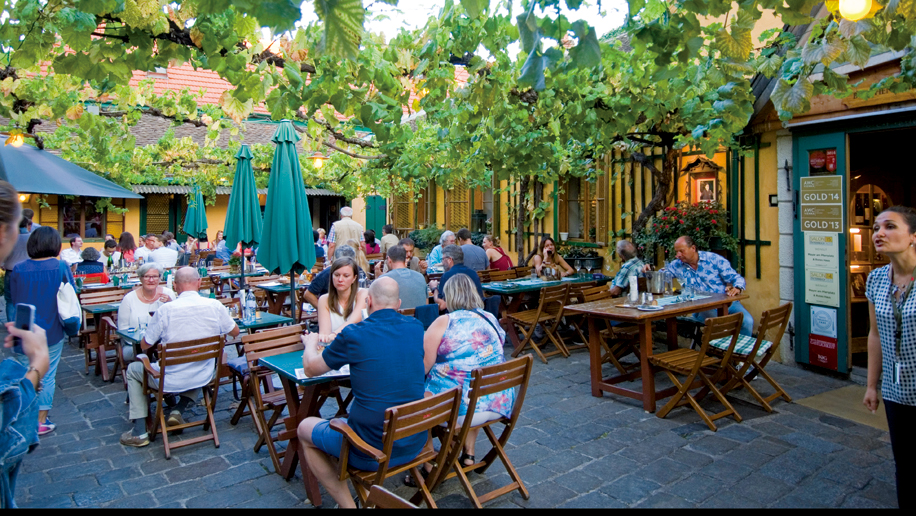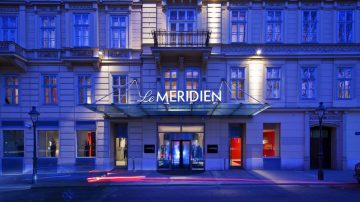
Jet lag has me wide awake at 4.30am, but for once I’m not annoyed, because this is my opportunity to explore a city that many consider one of the most beautiful and civilised in the world. By 5.30am I’m walking down the Austrian capital’s Ringstrasse (Ring Boulevard) towards the Donaukanal, once a broad bend in the Danube but now a regulated water channel that marks the northeast corner of Vienna’s old city centre.
I turn left to wander along its banks, lined with alfresco bars and cafés that, pre-dawn, are locked and lifeless, but during summer evenings buzz and bustle with city folk enjoying the balmy weather. The sky lightens as sunrise approaches, revealing artistic, colourful graffiti on the brick walls beside the canal. Early workers cycle past on clearly marked bike lanes as I turn south and meander through narrow streets lined by centuries-old five- and six-storey buildings that lead to Baroque churches and small squares. Coffee houses are already open for breakfast and doing good business – Vienna’s famed kaffeekultur (coffee culture) is a way of life here.
The streets are now crowded with people going to work and taking kids to school, but there’s not a single raised voice from a peeved child or irate commuter – all is orderly and calm. I emerge onto Sigmund Freud Park opposite the towering neo-Gothic Votive Church, its sharp twin spires piercing the clear blue sky. I follow the tram tracks past an impressive university building to Rathauspark, which sprawls out before the grand City Hall. Built between 1872 and 1883, it has an even more ornate façade than the famed Burgtheater across the road – Europe’s second-oldest theatre and home to the Austrian National Theatre. I pause for a minute, thinking of the pantheon of yesteryear’s superstars who must have passed through those hallowed doors – a who’s who from Europe’s artistic glitterati.
Even my accommodation – the Palais Hansen Kempinski Vienna – is in a heritage-listed building: built for the World Exhibition in 1873, it was leased to Kempinski in 2010; its three courtyards were given glass ceilings and have become the refined lobby lounge, Die Küche breakfast café and a multipurpose event space. As I munch on hearty Austrian bread and a sampling from the superb breakfast buffet selection, I consider the city and its many plaudits.

In 2016, Vienna earned top spot in the Mercer Quality of Living rankings for the seventh year in a row, while it was second (behind Melbourne) in the Economist Intelligence Unit’s Liveability Ranking. In part this is due to its 850 parks, which account for about 50 per cent of the city area, but there are many other factors: Vienna boasts more than 100 museums, 27 palaces, 120 concert halls and theatres, around 7,400 cafés, bars and restaurants, and each year it puts on 450 balls – dusk-to-dawn social extravaganzas, attended by young and old, that put most nations’ communal get-togethers to shame.
Then there’s the city’s devotion to good food and drink, plus a commitment to education and progressiveness – Vienna was ranked third in the Smart Cities Index by climate strategist Boyd Cohen. And let’s not forget its passion for music and the arts – unsurprising given this was the home of Mozart, Beethoven, Haydn, Schubert and the Strauss family, as well as playwright Arthur Schnitzler and artist Gustav Klimt, among many others.
Another important element is the architectural beauty of the city. The Vienna Historic Preservation Commission was created in 2003, and it designated the Innere Stadt (First District) as the Central Historic District, with a government ordinance put in place to stop any modern building or alteration of existing façades. The result is a de facto open-air museum of glorious architectural treasures, from Gothic to Baroque, Renaissance to Neoclassical. It is of course a Unesco World Heritage site in its entirety. In 2014, 6.2 million people visited Vienna – a lot for a small city of only 1.8 million people – and the majority stayed for most of their sojourn within the Ring Boulevard that replaced the old city walls and forms the First District’s circular border.
I do much the same; over the course of two days – which I advise is far too short a time to fully appreciate this most cultured of cities – I crisscross and circumnavigate the historic district, by myself and on guided tours. At just under three square kilometres it’s manageable on foot, but I buy a Vienna Card, which provides free travel on the underground, buses and trams for 48 hours (€21.90/US$23) or 72 hours (€24.90/US$27), as well as discounts for many of the top sights and tours, plus shopping and dining deals (wienkarte.at).

I visit the Vienna State Opera, one of the world’s most distinguished music venues, which was built in the mid-19th century and restored after being damaged in WWII. For those who can’t afford to buy a ticket, a huge screen on the side of the building streams live performances in the evening for everyone, with chairs provided – such is the city’s artistic altruism. I wander down history-rich streets past the Albertina museum, once the Habsburg royals’ residential palace, then the Hotel Sacher, home of sachertorte (the world’s most famous chocolate cake), before heading to the central focus of the Innere Stadt: St Stephen’s Cathedral.
Most people stop in St Stephen’s Square for a few minutes to stare in awe at the Gothic splendour of this 700-year-old masterpiece. The South Tower, built in 1433, shoots up, lance-like, 136 metres into the sky, but the North Tower was unfinished and in 1579 was capped by a Renaissance dome, which gives it a peculiar appearance but doesn’t diminish its imperious stature over the Renaissance and Baroque city crowding around it.
Graben, a storied and now pedestrianised and café-strewn thoroughfare, leads from
St Stephen’s Square west towards Kohlmarkt, another famous street lined with historic shops proudly displaying the royal insignia to show their status as purveyors to the crown. Gold and silversmiths stand opposite pastry shops such as the renowned Demel – a favourite of Queen Sisi, the wife of Emperor Franz Joseph I.
At the end of Kohlmarkt is the Hofburg, the Imperial Palace. This grand set of buildings was the centre of the huge Habsburg Empire, which ruled Central Europe from the 13th century right through to the early 20th century. It is home to the Sisi Museum in the Imperial Apartments, the renowned Spanish Riding School where beautiful white Lipizzaner horses dance an equine ballet, and a host of other museums, libraries, chapels and historical treasures.

I stroll past the rose bushes of Volksgarten (the people’s garden) to lunch at Café Landtmann, next to the Burgtheater. One of the city’s most famous and elegant coffee houses, it opened in 1873 and was frequented by the likes of Sigmund Freud, Gustav Mahler, Marlene Dietrich and, more recently, Hillary Clinton. Coffee houses in Vienna are renowned for their atmosphere of relaxed sophistication, where the concept of gemütlichkeit – roughly translating to mean a state of warmth, friendliness and good cheer – has been named on Unesco’s Intangible Cultural Heritage list.
As well as a broad menu of delectable coffees and delicious pastries, more substantial meals are available at Café Landtmann: Wiener schnitzel, tafelspitz (boiled beef) and beuschel (ragout made with heart and lungs) are all on the menu. I cannot resist the apfelstrudel or apple strudel, served either with whipped cream, vanilla sauce – or in my case both. Accompanied by a rich Viennese coffee, it is simply divine.
On my second day I venture outside the Ring Boulevard to Naschmarkt, a classic Viennese market just south of the Ring Road from the State Opera House, where you can buy and eat food from a wide range of countries, and purchase clothes, souvenirs and other sundries. I stop by the grandiose Art History Museum and Natural History Museum, which face each other across a green, landscaped plaza. A short walk away is a famous statue of Mozart, and a short tram ride on Line 1 around the Ring Boulevard to the Stadtpark (City park) on the eastern side of the First District brings me to two more statues of famous residents: first Beethoven, looking pensive in his own small square, then Johann Strauss, Vienna’s favourite son, depicted in gold playing his violin like a virtuoso.
Vienna is the only capital city in the world that produces a significant amount of wine within its city limits. On autumn weekends Viennese families like to head for one of the city’s many vineyard heurigers, courtyard taverns where local winemakers serve their produce along with substantial meals of grilled meat, sausages, breads and desserts. In the evening I drive 20 minutes out of town to Weingut Mayer am Pfarrplatz, a traditional heuriger where Beethoven lived for a time in small lodgings upstairs.
Surrounded by tables of friends singing old folk tunes to an accordion’s jolly jig, chattering couples and families of all ages, replete with wholesome food and fruity wine, I promise myself I’ll return to Vienna with my wife. Next time for longer though, and perhaps in winter, when the city’s famous Christmas markets in Rathaus Platz and St Stephen’s Square will provide the sort of gemütlichkeit that has charmed me during my short visit.












